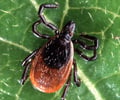Methods for preventing Lyme disease include preventing bites, controlling tick populations, and controlling the populations of other animals that ticks feed on.

‘Homeowners can keep ticks out of their backyards through landscape management, insecticide applications, and suppression of tick hosts such as deer and small mammals, especially white-footed mice.’





The blacklegged tick (Ixodes scapularis) carries and transmits a bacterium called Borrelia burgdorferi to humans, causing Lyme disease. The disease is usually spread to humans by bites from nymphal ticks (as opposed to larval or adult ticks), so Eisen and Dolan focused on studies concerned with host-seeking nymphs. Methods for preventing Lyme disease include preventing bites, controlling tick populations, and controlling the populations of other animals that ticks feed on. Effective methods of preventing bites include wearing long-sleeves, socks, shoes, and some form of insect repellent. Clothing can also be treated with permethrin, an insecticide that kills ticks.
Homeowners can keep ticks out of their backyards through landscape management, insecticide applications, and suppression of tick hosts such as deer and small mammals, especially white-footed mice (Peromyscus leucopus). Landscape management options include removing leaf litter, which can reduce the abundance of host-seeking nymphs by nearly 80 percent, and burning vegetation. Since ticks tend to be more abundant around the edges of yards or in wooded areas surrounding yards, barriers made from substances like gravel or wood chips may prevent ticks from entering a yard, but more research is needed about the specifics.
Certain pesticide applications show promising results, according to the authors, but the efficacy depends on the pesticide and method of application.
Targeting the hosts of the blacklegged tick can also reduce tick numbers. Controlling deer populations and/or treating deer with acaricides (pesticides that kill ticks) can significantly reduce blacklegged tick populations. Likewise, treating white-footed mice with acaricides can be effective. One method involves supplying mice with cotton balls that have been treated with permethrin, which is applied to the mice when they use the cotton as nesting material.
Advertisement












